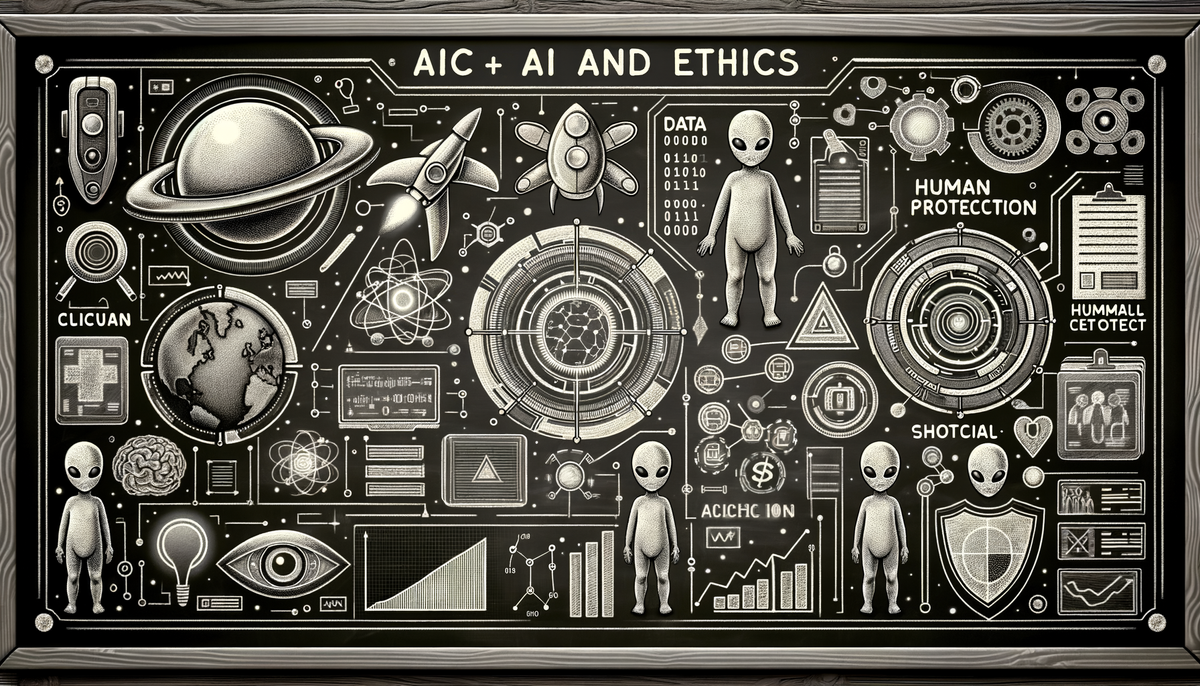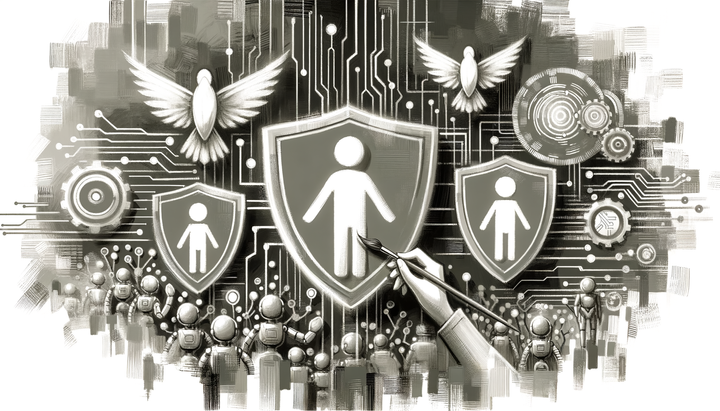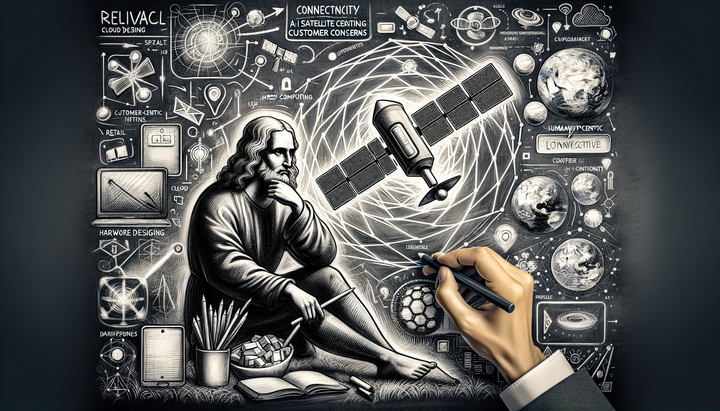AI Updates: Semiconductor Challenges and Consumer Innovations

This article explores the multifaceted impact of artificial intelligence across diverse sectors—from groundbreaking artistic installations and semiconductor market dynamics to smart consumer electronics and web browsing innovations. By weaving together insights from creativity-driven art exhibits, volatile semiconductor stocks, strategic data center shifts, AI-enhanced music streaming, next-generation smartphones and televisions, and even browser tab management, we delve into how AI is reshaping industries and everyday life.
The Interplay of Creativity and Technology in the Age of AI
Artificial Intelligence isn’t just about algorithms and data centers; it’s a pervasive force that is determining the contours of our cultural, technological, and economic landscapes. Over the past few years, we have seen AI creep into every facet of our lives—a journey that beautifully marries art with science and finance with creativity. In this article, we navigate through a series of recent developments that illuminate AI’s role in redefining art, business, and technology.
AI as a Medium of Artistic Expression
One of the most alluring manifestations of AI’s influence is vividly captured in the upcoming exhibit “AI: Art Intelligence” by Augustus Manly in Sonoma. Opening at the Gehricke Wines tasting room on March 29, this innovative showcase is not just a collection of artworks but rather a dynamic dialogue between artificial intelligence and human creativity. Manly’s meticulously curated collages span images from the 1940s to the modern day, representing an evolving narrative where tradition meets technological disruption. His work encourages us to “reconsider the role of the artist,” as technological advancements invite fresh perspectives on what it means to create art.
“AI is a tool. The choice about how it gets deployed is ours.” – Oren Etzioni
The exhibit’s integration of dynamic collages goes beyond the static display of art; it transforms each piece into an interactive storyline. As visitors wander through the tasting room, they’re urged to view the art as a living conversation—a blend of historical context and futuristic ingenuity. This approach resonates with the notion that art, much like technology, evolves with every new idea and breakthrough, continually challenging our preconceived notions of aesthetics and innovation.
Art has always been a reflection of society's pulse, and when AI enters the arena, it becomes not only a new medium but also a commentator on the human condition. Augustus Manly’s exhibit is a testament to this dual role, embodying both creative exuberance and critical reflection. It’s a perfect example of how AI can be harnessed to enrich cultural narratives, creating experiences that are as intellectually stimulating as they are visually captivating.
Market Dynamics and the Semiconductor Landscape amid AI Revolution
While art is one face of AI’s impact, the technology is equally pivotal in the world of business. The semiconductor industry, a backbone for AI hardware, has experienced significant volatility recently. Leading companies such as Taiwan Semiconductor Manufacturing Company (TSMC), Broadcom, and Marvell Technology have seen notable declines in stock value amid complicating geopolitical and economic factors.
A confluence of factors is behind this market turbulence. In one scenario, the U.S. government’s decision to place about 50 Chinese companies and an additional 30 non-Chinese firms on the “entity list” has stirred fears of restricted sales in critical markets. This measure, primarily aimed at curbing potential security risks, has ignited jitters among investors who worry about potential revenue losses. TSMC, a company that is pivotal for supplying AI chips to tech giants like Nvidia, found its stock plunging by 4.5%, while peers like Broadcom and Marvell experienced even steeper drops.
The sensitivity of the semiconductor market is further compounded by revelations that Microsoft has cancelled or deferred numerous data center projects—a move that, at first glance, seems to dampen the prospects for AI infrastructure expansion. Analysts from TD Cowen have highlighted that these cancellations, totaling around 2GW of capacity, not only cast a shadow on immediate demand but also hint at a broader overcapacity issue in data centers.
Despite the short-term turbulence, industry experts argue that these market movements are not necessarily reflective of a long-term decline in AI demand. Indeed, the fundamentals remain strong. After all, AI applications continue to surge, fueled by innovations in machine learning, deep neural networks, and edge computing. This nuanced narrative is evident in the analysis on Nasdaq, where market observers caution that while short-term stock fluctuations are concerning, they may also offer strategic entry points for long-term investments.
On a larger scale, the semiconductor market underscores a larger truth: AI's integration into everyday technology isn’t linear. It is a complex interplay of growth spurts and recalibrations—akin to the cyclical rhythms of economic tides. As companies like TSMC brace themselves for future growth, it’s clear that the current market volatility is setting the stage for a more resilient and adaptive AI ecosystem.
Strategic Shifts in the Data Center Landscape
In a related development, Microsoft’s recalibration of its data center capacity provides another layer to the unfolding AI narrative. The tech giant’s decision to scale back data center leases in the U.S. and Europe stems from a strategic reallocation of resources—an effort to manage an overabundance of capacity that no longer meets the revised workload projections. This move not only signals a shift in how companies manage AI training and inference demands but also paves the way for other major players, such as Google and Meta, to seize emerging opportunities.
Interestingly, this repositioning of Microsoft is prompting a subtle yet important shift in the competitive landscape. OpenAI, for instance, is making strategic moves by securing data center agreements directly with third-party providers such as CoreWeave. Its ambitious Stargate projects are testament to an industry in which adaptability and foresight override conventional strategies. In this evolving environment, AI is not just a technological increment—it’s a catalyst that is reconfiguring entire industries and compelling them to rethink investment in infrastructure.
The restructuring in the data center domain highlights a broader industry trend: rather than an outright retreat from AI, companies are adopting more efficient models of expansion and capacity utilization. It is a reality that even as market sentiment fluctuates, the long-term trajectory for AI-enhanced infrastructure remains robust.
Enhancing Daily Experiences with AI Innovations in Consumer Tech
Beyond the realms of art and semiconductors, AI is also revolutionizing the consumer experience. In particular, significant strides have been made in the music and entertainment industry. YouTube Music, for example, has introduced an array of updates that considerably enhance personalized music discovery. With features like “Ask Music,” users can experience unprecedented levels of customization. By simply instructing the platform with phrases such as “more upbeat” or “only female vocals,” the service tailors radio stations to reflect the user's mood and preferences with impressive finesse.
Moreover, AI-generated playlist titles and cover art designs are transforming how we interact with our digital music libraries. These innovations simplify the process of curating and accessing personalized content, thereby not just improving user satisfaction but also reinforcing the essential role of machine learning in everyday decision-making. As the digital music space becomes increasingly competitive, the intuitive deployment of AI features positions YouTube Music as a formidable player dedicated to enhancing user engagement.
This trend towards personalized content isn’t isolated to music. Across the board, AI-driven enhancements are making digital experiences more responsive and context-aware. Consider the recent updates from Opera One, which has integrated an AI assistant named Aria into its browser to handle tab management. Aria transforms the oft-overlooked process of managing browser tabs into an intelligent, interactive dialogue. Whether it’s grouping related tabs or closing unnecessary ones, the browser leverages AI to boost productivity, making digital navigation an easier and more engaging experience.
“The pace of progress in artificial intelligence is incredibly fast.” – Elon Musk
By automating mundane digital tasks, Opera One underscores a broader trend: AI is progressively becoming an indispensable tool in managing our digital lives, freeing up human mental bandwidth for more creative and strategic endeavors. Such innovations in user-interface design are poised to redefine our interaction with technology, creating systems that are both proactive and highly adaptive to individual needs.
Revolutionizing Mobile and Home Entertainment Experiences
Consumer devices have always been at the forefront of invoking AI-powered transformations. Samsung, one of the leading innovators in this space, has demonstrated this vividly with its recent launches in the mobile and home entertainment sectors. The Galaxy A26 and A36 smartphones highlight the trend of embedding AI into affordable yet premium devices. These smartphones offer advanced features such as real-time translation, music identification powered by Google’s Circle to Search, and sophisticated camera editing tools that utilize AI. The strategic integration of these features not only elevates the user experience but also democratizes access to advanced functionalities that were once exclusive to high-end devices.
But Samsung’s commitment to leveraging AI doesn’t stop at mobile. Their 2025 television lineup warrants special mention, featuring colossal displays that push the boundaries of home entertainment. With screen sizes scaling up to 115 inches and resolutions reaching 8K, these TVs offer an immersive viewing experience. Equipped with cutting-edge AI capabilities like real-time translations and motion control integration with Galaxy Watches, these televisions signal a convergence of aesthetics and technology in ways that compel us to rethink the living room as a domain of interactive engagement.
Whether it is the Galaxy A series or the new generation of Samsung televisions, these products are emblematic of a broader market shift wherein affordability meets sophistication—all thanks to AI. By providing enhanced imaging, superior display technologies, and innovative functionalities, Samsung is paving the way for a future where every consumer interaction is enriched by intelligent design. It is an exciting glimpse into a future where technology doesn’t just serve functional purposes, but becomes a seamless part of our lifestyle narrative.
Interdisciplinary Convergence: Art, Semiconductors, and Consumer Tech
Each of these developments, when seen in isolation, might appear distinct. However, the underlying thread connecting them is the transformative potential of AI. Whether it’s the artistic reimaginings found in Augustus Manly’s “AI: Art Intelligence,” the market recalibrations driven by semiconductor dynamics, the strategic data center shifts by tech giants, or the enhanced experiences in music streaming and smart consumer electronics—AI is at the heart of it all.
This interdisciplinary convergence highlights an essential fact: AI is both a disruptor and an enabler. It challenges existing paradigms in art and business while simultaneously offering sophisticated tools that enhance everyday life. Such a dual role is what makes AI particularly intriguing. By empowering creators, investors, and technologists alike, AI fuels a cycle of continuous innovation and reinvention.
Let’s not overlook the broader implications of this technological symbiosis. Each AI-driven innovation we’re witnessing is part of an interconnected ecosystem that includes everything from artistic expression to stock market fortunes and consumer tech advancements. The coming years are likely to see these boundaries blur further as industries become more interdependent. For instance, advancements in semiconductor technology will drive more potent AI algorithms, which in turn will lead to smarter consumer devices and even more immersive digital experiences.
This confluence of technology and art reminds me of a classic proverb: “Innovation distinguishes between a leader and a follower.” In every sphere—from the tradition-steeped galleries of Sonoma to the bustling trading floors influenced by geopolitical shifts—those who understand and harness AI are poised to lead in the next wave of technological revolution.
Insights and Future Perspectives
Reflecting on these diverse stories, several insights emerge regarding the future trajectory of AI. First, while market volatility in sectors such as semiconductors may prompt caution among investors, it’s important to recognize that such disruptions are often a precursor to more sustainable, long-term growth. The recent plunge in semiconductor stocks, spurred by geopolitical uncertainties and recalibrated investments by companies like Microsoft, should be seen not only as a challenge but as an opportunity for strategic realignment and expansion.
Second, AI’s evolving role in art and creative domains, as evidenced by the “AI: Art Intelligence” exhibit, opens doors for a richer dialogue between human ingenuity and technology. Such creative collaborations are likely to redefine artistic culture in an era where technology is both muse and medium.
Third, consumer excitement around AI-driven features—from personalized radio stations on YouTube Music to enhanced AI assistants in browsers like Opera One—illustrates the capacity of intelligent technologies to improve daily experiences. As these tools become more integrated into our lives, they will shape everything from how we consume media to how we manage our workflow, ensuring that our digital environments are intuitive and responsive.
Finally, devices like Samsung’s latest smartphones and televisions encapsulate the democratization of high-tech functionality. With the infusion of AI into accessible price bands, technology is becoming a universal language that invites participation across all segments of society. Consumers are no longer bound by the high costs typically associated with cutting-edge technology—they can now experience smart innovation at affordable prices, thereby driving wider adoption and fostering greater digital literacy.
Moreover, linking these themes with insights on emerging geopolitical and economic trends offers a window into the complexities and promises of the ongoing AI revolution. For instance, while U.S. regulations have set off waves of uncertainty in semiconductor markets, the underlying demand for AI-driven innovation remains undiminished, thus offering fertile ground for future breakthroughs and investments. Similarly, strategic shifts like Microsoft’s data center readjustment may be a harbinger of a more efficient, competitive landscape—one that accommodates newer players and innovative business models.
Further Readings and Cross-References
For those eager to explore more on related topics, consider diving into additional stories on the AI.Biz website. Articles such as TSMC’s Groundbreaking Investment in AI, TSMC’s Sales Quicken In a Competitive AI Landscape, TSMC and AI: A New Era of Growth, and TSMC’s Bold Move: A $100 Billion Chip Investment delve deeper into the semiconductor sector’s critical role in powering the AI revolution.
Similarly, updates from sources such as Yahoo Finance and Nasdaq lend perspective on how AI is influencing market dynamics and corporate strategies. Independent coverage of technological innovations on platforms like Android Central and 9to5Mac further highlights AI’s transformative power across domains, from personalized digital music to intelligent browser experiences.
Concluding Thoughts
As we stand on the threshold of a new era defined by rapid technological evolution, it becomes increasingly clear that artificial intelligence is not a monolithic force; rather, it is a rich confluence of creativity, strategy, and innovation. From art exhibitions that reimagine the boundaries of creative expression to market shifts in semiconductors and sophisticated consumer technologies that adapt to our personal needs, AI is weaving together a future that is at once unpredictable, yet profoundly promising.
Whether you see AI as “the best or worst thing ever for humanity” or simply as a powerful tool—a sentiment echoed by visionaries like Elon Musk and Oren Etzioni—its presence is undeniable and its impact, far-reaching. As we continue to navigate this evolving landscape, it is essential to remain attentive to the interplay between creativity and technology, ensuring that our societal and cultural fabric keeps pace with the relentless march of innovation.
In the words of a forward-thinking observer, sometimes a recalibration of perspective is all it takes to recognize that the future is not something to fear, but to embrace—with all its unpredictable turns and transformative innovations.



Comments ()